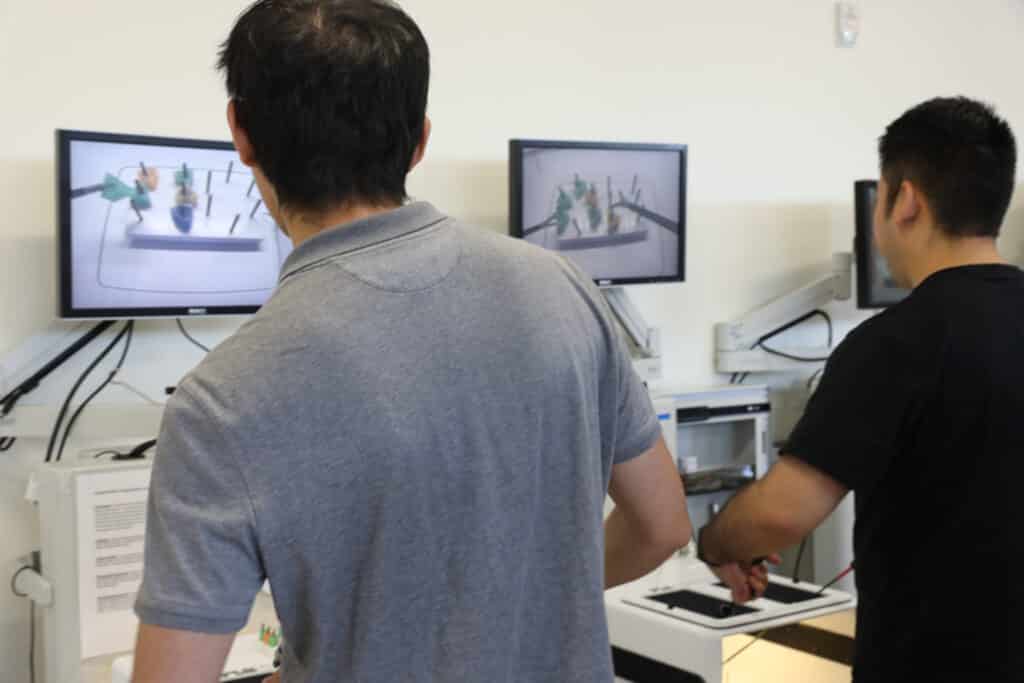Engineering Graduate Students Explore the Medical Side of Robotics
Intro to Medical Robotics offers a comprehensive introduction to the field, focusing on technical instruction and real-world problem solving through multiple projects.

Duke’s Surgical Education and Activities Lab (SEAL) is providing a rare opportunity for students to get their hands on today’s fancy surgical robotics, and they’re going to change the future because of it.
This comes by way of the Introduction to Medical Robotics course offered to engineering students, a class crafted by Siobhan Oca, assistant director of master’s studies for robotics and autonomy and assistant professor of the practice in MEMS, and Brian Mann, fellow MEMS professor.
The course covers technical instruction in core areas of surgical technology and involves the completion of three small projects where trainees address real-world problems in surgery. A key component of the course is a collaboration with the SEAL Lab, in coordination with Sabino Zani Jr., SEAL Lab co-director and a professor of surgery at the Duke University School of Medicine.
A state-of-the-art surgical simulation center, the SEAL Lab was designed to provide advanced and innovative training for physicians, medical students, health care providers, and industry professionals in a risk-free environment.

And students are learning more ways to merge medicine and engineering through the course.
Like second year biomedical PhD student Morgan McCloud, who finished her stint as an undergraduate and thought that she would jump straight into industry. What she didn’t anticipate was how quickly plans would change during the pandemic.
“I thought that was the plan after graduating, but actually during that time, I ended up applying to be a Pratt Research Fellow,” McCloud shared.
The 10-week, full-time internship is open to undergraduates and provides financial support, as well as the opportunity to work alongside faculty members to conduct authentic research. McCloud was accepted and paired with the Izatt lab, where she was mentored by Ryan McNabb, a medical instructor in the department of ophthalmology.
She instantly fell in love with the work.
“I had so much fun working with that group,” McCloud said. “It didn’t hit me until later on how much I loved research and enjoyed being able to do cutting-edge work.” She engaged with other surgeons in the field and collaborated with labmates like Kristen Hagan, who currently works at SpaceX, and Pablo Ortiz, who is now at Amazon Robotics.
McCloud knew that her future was out in the world of medical devices as an engineer. Enter Duke’s Traineeship for the Advancement of Surgical Technology (TAST), the NSF National Research Traineeship that provides a new training framework for graduate students in convergent medical disciplines. “I know in the future I want to work with medical devices in some capacity as an engineer,” she explained. “It was important to me to be exposed to engineers working on medical devices and working with doctors right now.”
And it was through TAST and her graduate program that McCloud got to experience Introduction to Medical Robotics.

McCloud says she was exposed to robotics in radically new ways through the course. “When we were in the SEAL Lab, we had the chance to listen to and learn from a variety of doctors and doctor-engineers that combined medicine and engineering research,” she said. For students like her, the opportunities offered by the SEAL lab were especially unique because it included multidisciplinary-focused research.
Tanner Zachem, a second year PhD student in mechanical engineering and a TAST fellow in Patrick Codd’s Brain Tool Laboratory, says courses like Intro to Medical Robotics only strengthened his research methodologies. His work with advisor C. Rory Goodwin, a neurosurgeon and spine surgeon, also highlights the interdisciplinary relationship happening in engineering and medicine at Duke.
“Few, if any, institutions have the relationships we have at Duke between Pratt and the hospital,” Zachem said. “One of the things that sold me as an undergraduate, and made it an easy decision to stay for graduate school, was that we’re right across the street from the hospital and medical school.”
For many students, getting to work in the SEAL Lab is their introduction to the interconnected relationship fostered between medicine and engineering at the university. “It’s really helpful for engineers who may have never been in a clinical environment to see how surgery is done,” Zachem explained. “They get to see how to suture, work hands-on with medical instruments, and hear insights from incredibly talented surgeons.”

Doctors and faculty have even performed simulations for students using some of the state-of-the-art equipment on hand, like the Fundamentals of Laparoscopic Surgery towers, a procedure that uses small incisions to examine and treat conditions in the abdomen or pelvis. The towers are used to hone in on the basics of laparoscopic surgery skills and consist of a FLS box, camera, and lap-instruments that the learner uses to perform specific tasks to practice laparoscopic skills.
“Interacting with surgical tools directly allows engineers to better understand problems and therefore create better solutions,” Zachem shared. “Watching the doctors, residents and senior medical students perform these tasks with incredible efficiency was amazing. I don’t think a robot can do tasks that effectively and gracefully yet, but being able to work in the SEAL Lab allows us to see how much there is left to innovate.”
